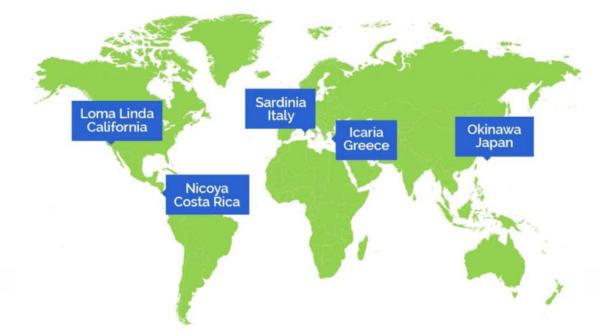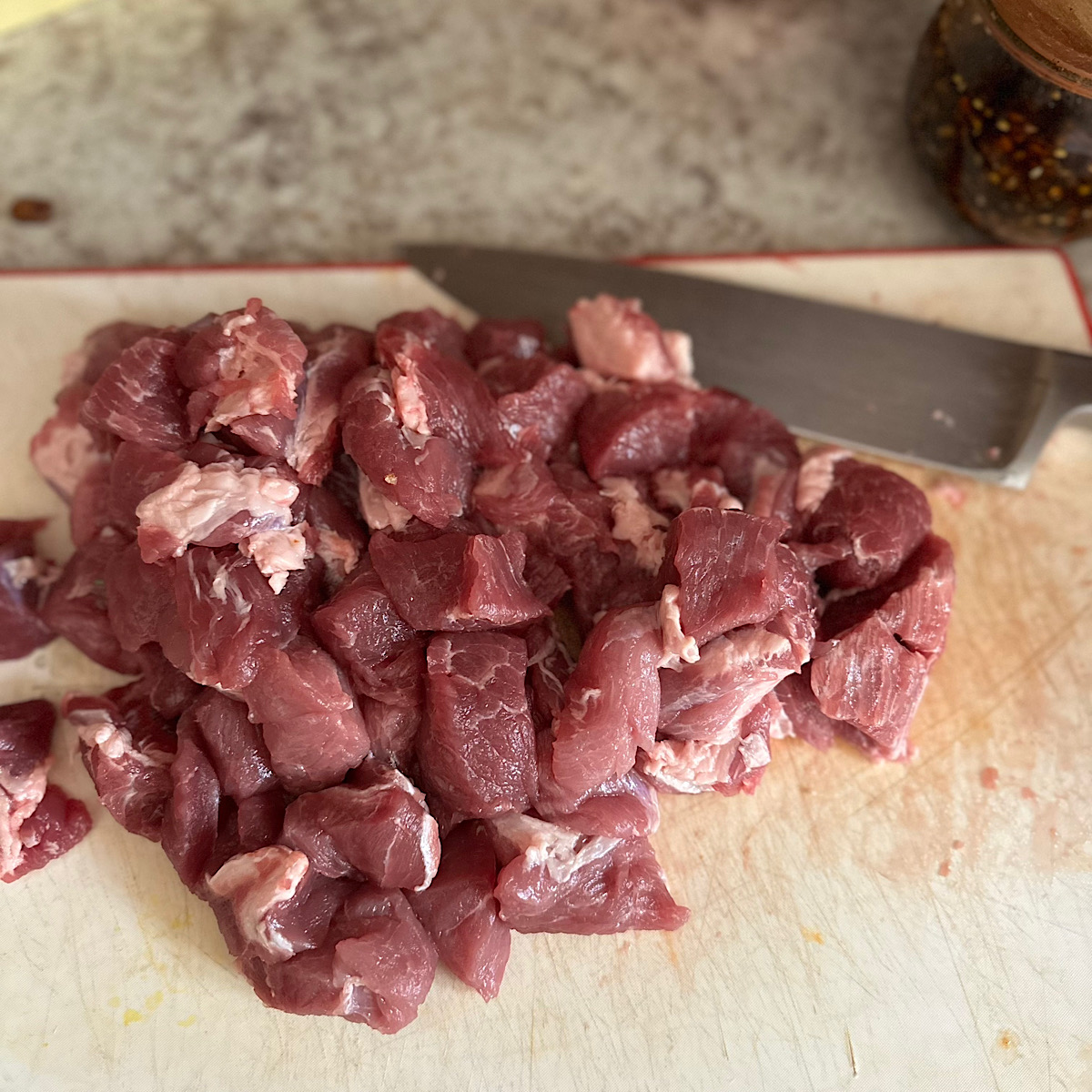Pozole (aka Posole) is such a flavor-filled, rib-sticking, satiating meal that it is difficult to be convinced that it has a place on any kind of diet. All of the ingredients in this Pozolillo de Garbanzo however are compliant with the slow carb diet (aka 4-hour body) and can work for low carb lifestyles.

Jump to: RECIPE | Traditional Pozole vs Slow Carb | Beans and Slow Carb Diet | Ingredients | Illustrated Step by Step
This post may contain affiliate links, and you can read our disclosure information here–
Traditional Pork Pozole Rojo (with hominy)
Traditional pork pozole is a slow cooked pork stew with hominy, chile peppers and aromatics. While the traditional version is not high in calories, the hominy is essentially white corn kernels and is fairly high in starch/carbs.
This version of the Mexican pork and hominy stew is a classic red pozole, which I learned from a wonderful hispanic woman from the Bajío region of Mexico. While it is fairly simple, it does take some time to come together.
It is usually made in large batches for crowds and celebrations.

The recipe below, while not “authentic” is an excellent pozole with garbanzo beans standing in for the hominy. And if you don’t like garbanzo beans, here is another slow carb version of pozole made with navy beans (also the easiest version as it is made in the slow cooker).

Why are Beans Compliant with a Slow Carb Diet?
Beans and legumes are allowed on Tim Feriss’s slow carb diet, but after working with many clients on this diet I have found that it is fairly easy for people to stall out their weight loss by overdoing it on bean/legume consumption.
Based on various podcasts or interviews of Ferriss, I have come to the conclusion that he included beans for three reasons:
- They are indeed a carb but they don’t spike blood sugar like the refined carbs do.
- When you eat mainly protein and vegetables, it is common to get fatigued at first. Beans and legumes offer a slow carb way to offset fatigue.
- If you are doing a vegetarian form of slow carb, beans and legumes are going to be very important.
The garbanzo beans in this Pozole recipe offer a lot more protein and slow carbs compared to high carb hominy, which is why I chose garbanzos as a substitute.
Beans as a Global Staple for Protein
So are beans necessary to a slow carb lifestyle? They can certainly be a benefit if other sources of protein are unavailable or too expensive.
I like to approach the health aspect of beans and legumes using one of the key findings of a world-wide study on longevity funded by National Geographic, called the Blue Zones Study.
Dan Buettner, team leader of the Blue Zones project, and his team chose 5 geographic areas of the world that had the longest-lived (and healthiest) people. The five geographic regions included:
- Sardinia, Italy
- Okinawa, Japan
- Loma Linda, California
- Nicoya Peninsula, Costa Rica
- Icaria, Greece

After identifying these areas, the Buettner team analyzed what characteristics the five areas shared to try and tease out why the people lived so long and why they were relatively free of disease.
I will list the characteristics below, but the interesting thing to me with respect to diet was that the overall diets of these areas were very different from each other. The only dietary ingredient that each region shared was a cup of beans a day.
The rest of the characteristics the long-lived people shared were more along social and cultural lines. Here is a list of the shared characteristics that contributed to their longevity:
- Family – put ahead of other concerns
- Less smoking
- Semi-vegetarianism
- Constant moderate physical activity (as a part of daily life rather than exercise routines)
- Rich social and community networks
- A cup of legumes/beans a day was a cornerstone characteristic of diet
So, if you want to know more about this fascinating project, Dan Buettner has written a series of books about the specific findings on Blue Zones. One of the books focused on recipes is a Blue Zones meal plan/cookbook.
Replacing Hominy in Pozole with Garbanzo Beans
Pozole is a very popular stew, traditionally made with hominy. Hominy is dried field corn (not sweet corn) that has gone through a process of removing the hulls and then plumping up the inner kernels.
The texture of hominy is a slightly chewy kernel with a mild savory flavor likened to grits or tortillas. It does not taste like fresh corn.
Although hominy is a low-fat food, it is not low carb. A one-cup serving has about 119 calories and about 24 grams of carbs. While there is quite a bit of fiber in hominy that can offset the carbs, it is low in protein (2.4 grams per cup).
Slow carb diets stress getting an abundance of protein to be successful. Substituting garbanzo beans for hominy in pozole will not make it a low carb dish but it will increase the amount of protein from 2.4 grams per cup to 15 grams per cup.

That is a significant increase in protein if you are making a vegetarian pozole on a slow carb diet.
Another alternative for an easy slow carb pork pozole would be this ancho-spiced pork posole with navy beans.

Ingredients:
The following photo shows you all the ingredients you will need for this recipe. For details on measurements, see the recipe below.

Illustrated Step by Step:





If you enjoy all types of Mexican food, check out this category of ALL Mexican recipes, where you will find over 40 Mexican recipes, from casual, to low carb, to fancy.
Slow Carb Pozole with Garbanzo Beans
Equipment
- Dutch oven (Or large ovenproof pot)
- Strainer (Colander)
Ingredients
- 2 cups garbanzo beans
- 2 tablespoons olive oil
- 2 pounds pork shoulder cut into 1-inch (bite size) cubes
- 1 teaspoon salt
- 1 large` onion chopped
- 2-3 cloves garlic minced
- 1 teaspon dried oregano
- 2 teaspoons smoky ancho blend
- 1 teaspoon chipotle spice
- 1 ½ teaspoon unsweetened cocoa
- 10 cups chicken stock
- garnishes options include avocados, chopped red onion, chopped cilantro, sliced radishes, or lime wedges
Instructions
- Preheat oven to 325 degrees FIf using dried beans, soak them in 8-9 cups of water overnight or for about 8 hours and then rinse before using (measure the 2 cups after soaking). If using canned garbanzo beans, pour them in a strainer and rinse the gel off.2 cups garbanzo beans
- In a large Dutch oven (or oven-proof pot), heat 1 tablespoon oil over medium high heat. Season the pork with salt and pepper and brown the pork on all sides. You will need to work in 2 batches to get a good sear (maybe 3 batches if your pot is smaller). Do not overcrowd the pan. I added the second tablespoon oil in the second batch. It takes about 5-8 min. per batch.2 tablespoons olive oil, 2 pounds pork shoulder, 1 teaspoon salt
- When all of the pork is seared, return all the meat to the pot and add the onions and garlic. Saute the onion and garlic with the pork over medium heat, stirring occasionally for around 5 minutes.1 large` onion, 2-3 cloves garlic
- Add garbanzo beans, oregano, ancho spice, chipotle spice, cocoa, chicken stock to pot and stir to combine. Salt and pepper to taste at this point.1 teaspon dried oregano, 2 teaspoons smoky ancho blend, 1 teaspoon chipotle spice, 1 1/2 teaspoon unsweetened cocoa, 10 cups chicken stock, 2 cups garbanzo beans
- Bring the mixture to a boil, stirring occasionally, and then cover the pot and place it in the oven for about 2 hours, or until pork is tender.
- Ladle the pozole into bowls and garnish and serve.garnishes



Sounds delicious, I love garbanzos, and plan to make this. Question — is that 2 cups dry or 2 cups soaked garbanzos? If the latter, I’m assuming about 2/3 – 1 c dried to come up with 2 cups soaked? Thanks!
Well Elizabeth I just dumped a small bag of dried in a bowl of water in the morning and let them soak most of the day. Then I measured them to around 2 cups, but it was after they were soaked. It actually ended up being a little more than 2 cups. If you used canned beans I would use both 14 oz cans. It really doesn’t effect the taste of the pozole, it’s just how many beans you want in your stew. I would probably use less next time as it was too filling for me.
[…] Pozole with Garbanzo Beans – Slow Carb Cooking – Farm to Jar Food on May 23, 2019 at 3:58 pm […]